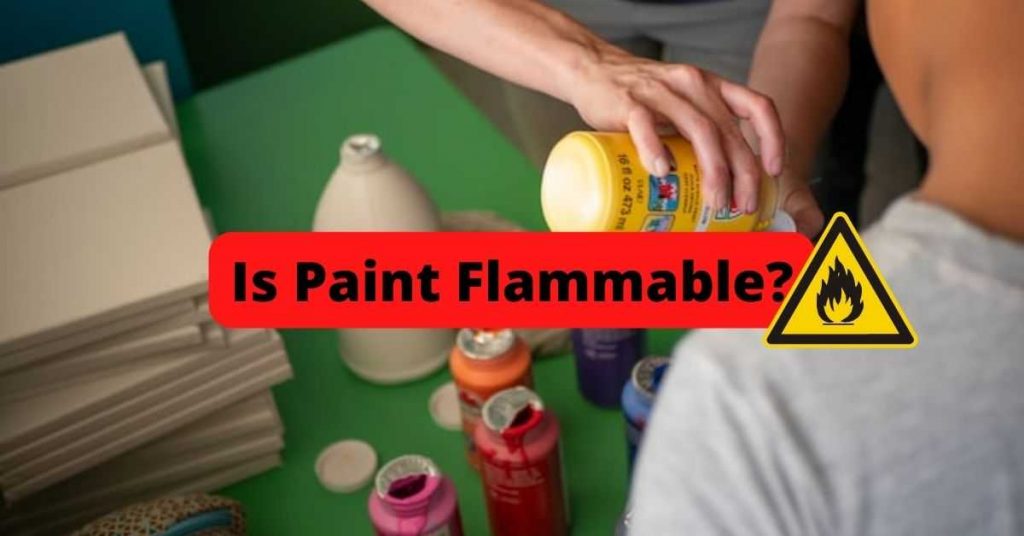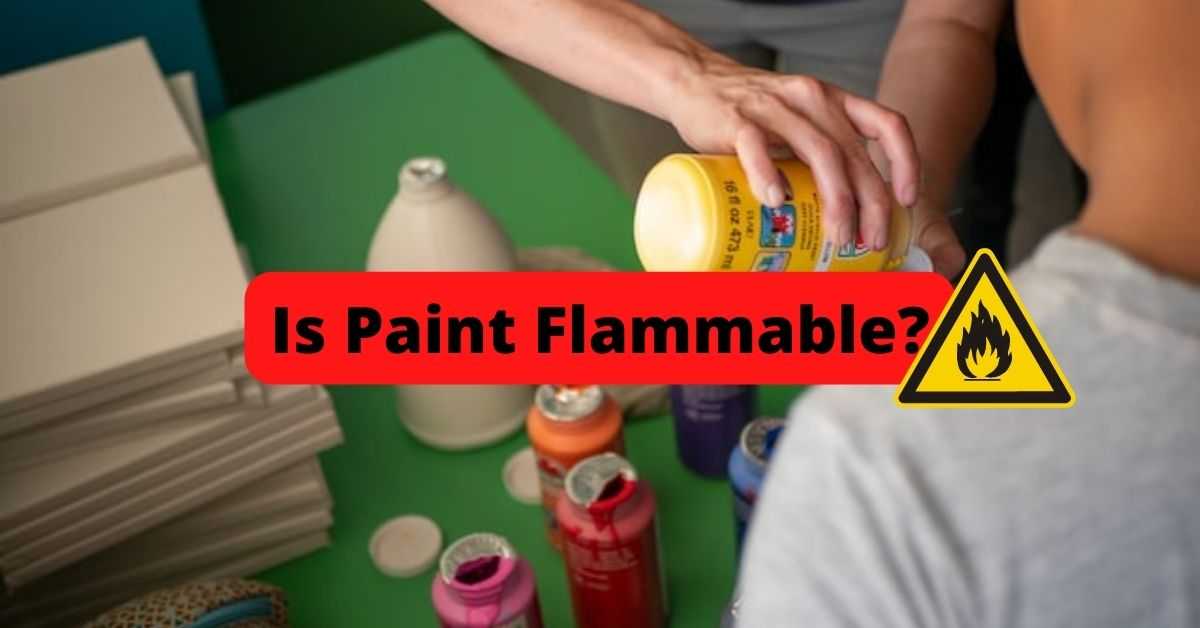Last Updated on March 26, 2024 by Masha Eretnova
Acrylics are generally safe to use but what if we want to paint on lamps, candle holders or a lighter? Will they catch on fire or is it safe?
Especially when we use a torch for removing bubbles from a fresh acrylic pour – are we in danger?
Read the label first, if the paint you are about to buy is water-based it will act like acrylic paint – non-flammable while wet, but combustible when dry. If you find a paint or a medium that contains solvents, spirits, alcohol, or oils – they will be flammable while wet and safe once they dry.
Wet latex and acrylic paints are considered non-flammable, but when acrylic paint dries it becomes combustible and can catch fire.
Pay attention as we discuss which paints are flammable and combustible or whether or not you should use them on your DIY home projects, so tune in!
Flammable vs Combustible: same thing? In Plain English
Flammable and combustible are NOT the same, even though sometimes used synonymously.
| Flammable | Combustible |
| – Burns at room temperatures 22 °C – 37.8C max (72 °-100F) – it will catch fire with a lighter. – Low flash point – Ex., wet oil-based paints, spray paints, spirits, and solvents | – These burn at higher temperatures 37,8 to 93,3 C (100-200F). Need heat to burn. – Higher flashpoints (above 100°F) – Ex., most dried paints |
Combustible liquids require heat to ignite, whereas flammable liquids burn at room temperature. Therefore, the temperatures required by flammable and combustible materials to ignite a fire are different.
According to NFPA, when exposed to an ignition source, flammables will ignite at lower temperatures of 37.8 ºC than combustibles. At the same time, a substance is deemed combustible if its flash point is more than 37.8 ºC but lower than 93.3 ºC.
It is important to know that there are also fire-retardant paints, that are safe to use on barbecues, radiators, and close to heat sources. Those paint will be specifically labeled as fire-resistant, most acrylics or oils are not considered fire-retardant.
Is acrylic Paint flammable or Combustible?
Acrylic paints are made with water and are not flammable while wet.
But it doesn’t make acrylic paint heat-resistant.
So What happens if acrylic Paint gets hot?
Acrylic paints will probably be harmed if exposed to intense heat, especially acrylic latex paint. It can fade faster or get deformed.
When heated, it becomes more malleable and less likely to break. It can resist temperatures of up to 200 F degrees before collapsing.
Since acrylic paint is water-based, it is not flammable when wet, but the water particle evaporates as it dries, changing its characteristics – it forms a thin plastic film.
Dried acrylic paint, as a fil, consequently turns flammable.
Dried acrylic paint will burn at about 560 degrees Fahrenheit (293.3 degrees Celsius), the same as acrylic resin and then it starts to melt.
Dried acrylic painting can catch fire and is combustible as it also has paper or canvas and wooden support underneath.

Because it can burn, acrylic paint is regarded as a combustible liquid. Nevertheless, water-based paints like acrylics are less combustible than oil or spray varieties of paint.
Therefore, it is suggested that you always observe the safety recommendations on the package while using paint of any kind. In addition, ensure you are in a well-ventilated location and do not smoke when using flammable liquids like acrylic paint.
Painting surface also defines how combustible or flammable is the whole painting. Painting with acrylic on wood will for sure make the art combustible as wood burns.
Dried acrylic paint Can Catch Fire. But Rarely Does
It’s true that dried acrylic paint has the potential to catch fire and is indeed flammable or combustible.
However, although it is not considered hazardous, it burns more slowly than paints with an oil base.
But to be fair, the temperature has to be so high and the source of the fire has to be directly interacting with paint for quite some time before it starts melting or burning.
In reality, it is a truly rare case!
Wet acrylics will never catch fire so they are safe to paint with.
What about the fumes?
Regular water-based acrylics we use for painting don’t release any flammable toxic fumes.
The majority of acrylic paint manufacturers are trying to make paints flame-retardant.
On the other hand, hazardous compounds such as ammonia, formaldehyde, and metallic pigments or mercury may still be present in some paints, in that case, it has to be clearly stated on the label.
What about other tools we use for acrylic painting?
Other paints and mediums contain certain hazardous substances and can potentially be flammable. Once more, it will depend on these materials’ chemical properties.
- Mediums and tools for painting
Paper, canvas, wooden easels and frames, chairs, and brushes are combustible. They won’t spontaneously catch fire while, but they can burn if you put a fire beneath them for a considerable time.
Related: 14 Tips How to Clean Acrylic Paint Brushes [The Ultimate Cleaning Guide]
- Quick-drying media
Even though the solvents are practically odorless, you should work in a well-ventilated area because they are toxic and flammable.
- Sealer and varnishes
Yes, acrylic paint sealer is flammable at 110°F high temperatures. It might also catch fire if put close to an open flame or a fireplace.
In addition, solvent-based sealers can be ignited, even from a tiny spark, if used in an inadequately ventilated environment. They are also harmful to human health.
Some of its hazards are harmful if inhaled and in contact with the skin and can irritate the skin. Therefore, it is advised to avoid breathing in dust, fumes, and vapors and stay away from heat, sparks, open flames, and hot surfaces.
Related: How to Varnish an Acrylic Painting
Safety tips for working with Acrylic Paint and torch or heat
To save yourself and your family, you must take specific precautions and safety procedures when painting indoors.
Tip 1. Work in a Properly Ventilated Setting
When using paint, you must ensure the workspace has enough ventilation. For example, maintain an open window and door to encourage optimal airflow.
Tip 2. Utilize Safety Gear
When working with paint, put on safety goggles and a respirator. You will be shielded from any potential spills or smells by these items.
Tip 3. Keep Away From Acidic Materials
A paint can react chemically in a potentially hazardous way with acids and other acidic chemicals. Therefore, you must keep the two separate at all times.
Tip 4. Avoid Flammable Materials
Paint should not be used near heaters, combustibles, liquids, or open flames since it is flammable.
Tip 5. Never Smoke Near The Area
Considering the risks associated with keeping paint close to heat, it might seem straightforward, but smoking around paint thinners is hazardous. The paint can ignite uncontrollable flames if it touches an open flame.
Tip 6. Practice Proper Disposal
Paints must be disposed of under the standards and guidelines specified for their use since it is a hazardous waste. Never dispose of paint in ordinary trash or down the drain.
Related: 51 Simple Acrylic Painting Tips for Beginners & Pros
flammable or combustible Paints [Full Table]?
We have created a flammability comparison table for paints to make it much more straightforward. Here’s a brief guide to help you determine whether the paint is flammable or combustible.
As you can see the most fire-safe paint is chalk paint. Most wall paints are emulsion or latex paints which makes them safe to use indoors as well.
| Type of Paint | Flammable When Wet | Flammable When Dry | Combustible |
| Oil-Based Paint | ✔ | ✘ | ✔ |
| Water-based Paints | ✘ | ✔ | ✔ |
| Acrylic Paint | ✘ | ✔ | ✔ |
| Acrylic Latex Paint | ✘ | ✘ | ✔ |
| Water-based Enamel Paint | ✘ | ✔ | ✔ |
| Oil- or Solvent-Based Enamel Paint | ✔ | ✘ | ✔ |
| Acrylic Paint Fumes | ✔ | ✔ | ✘ |
| Chalk Paint | ✘ | ✘ | ✘ |
| Spray Paint | ✔ | ✘ | ✔ |
| Emulsion Paint | ✘ | ✔ *There are fire-retardant emulsion paints | ✔ |
| Paint Thinner | ✔ | ✘ | ✔ |
| Acrylic Lacquer Paint (spray) | ✔ | ✘ | ✔ |
| Acrylic Sealer | ✔ | ✘ | ✔ |
| Tamiya Acrylic Paint | ✘ | ✔ | ✔ |
| Liquitex Acrylic Paint | ✘ | ✔ | ✔ |
FAQ section
Is Tamiya acrylic Paint flammable?
Tamiya sells water-based, non-flammable acrylic paint. But they also have some spray paints. Tamiya spray paint is flammable. Flammable liquids and vapors comprise isopropanol + glycol ethers. In addition, this is primarily used for painting miniatures.
Is Liquitex acrylic Paint flammable?
Acrylic paints by Liquitex are non-flammable. Everyone can safely paint with Liquitex acrylic paints because they all bear the AP seal from the ACMI (Art and Creative Materials Institute, Inc.). These paints are a lot of fun to use and contain non-toxic materials.
Can I paint a candle with acrylic Paint?
As long as you choose acrylic paint that is non-toxic and water-based, you can safely paint your candle. It is recommended to stick to smaller designs rather than painting the entire candle and let the freshly painted candle sit overnight before lighting it.
Summary
Remember that water-based paints like acrylics are safe for your DIY home projects, and their liquid form is non-flammable.
Yet, I urge you to keep suitable safety precautions and proper disposal in mind and not overheat acrylics with a torch or open flame.

Masha Eretnova, born in 1991, is a Buenos Aires-based certified teacher, artist, and member of the Professional Artist Association with 20+ years of personal painting journey.
She started painting and drawing very early and is now an international abstract artist and educator passionate about acrylic painting, gouache, and crafts.
Her works are part of international exhibitions and contests, including ArtlyMix (Brazil), Al-Tiba 9 (Spain), Exhibizone (Canada), Italy, and many more.
Besides her artistic pursuits, Masha holds a post-grad diploma in Teaching Film Photography and 2 music school diplomas: piano and opera singing.
